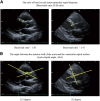Ventricular Sigmoid Septum as a Risk Factor for Anthracycline-Induced Cancer Therapeutics-Related Cardiac Dysfunction in Patients With Malignant Lymphoma
- PMID: 35434414
- PMCID: PMC8977195
- DOI: 10.1253/circrep.CR-21-0145
Ventricular Sigmoid Septum as a Risk Factor for Anthracycline-Induced Cancer Therapeutics-Related Cardiac Dysfunction in Patients With Malignant Lymphoma
Abstract
Background: Identifying risk factors for cancer therapeutics-related cardiac dysfunction (CTRCD) is essential for the early detection and prompt initiation of medial therapy for CTRCD. No study has investigated whether the sigmoid septum is a risk factor for anthracycline-induced CTRCD. Methods and Results: We enrolled 167 patients with malignant lymphoma who received a CHOP-like regimen from January 2008 to December 2017 and underwent both baseline and follow-up echocardiography. Patients with left ventricular ejection fraction (LVEF) ≤50% were excluded. CTRCD was defined as a ≥10% decline in LVEF and LVEF <50% after chemotherapy. The angle between the anterior wall of the aorta and the ventricular septal surface (ASA) was measured to quantify the sigmoid septum. CTRCD was observed in 36 patients (22%). Mean LVEF and global longitudinal strain (GLS) were lower, left ventricular mass index was higher, and ASA was smaller in patients with CTRCD. In a multivariable Cox proportional hazard analysis, GLS (hazard ratio [HR] per 1% decrease 1.20; 95% confidence interval [CI] 1.07-1.35) and ASA (HR per 1° increase 0.97; 95% CI 0.95-0.99) were identified as independent determinants of CTRCD. An integrated discrimination improvement evaluation confirmed the significant incremental value of ASA for developing CTRCD. Conclusions: Smaller ASA was an independent risk factor and had significant incremental value for CTRCD in patients with malignant lymphoma who received the CHOP-like regimen.
Keywords: Anthracycline-induced cardiotoxicity; Aorto-septal angle; Cancer therapeutics-related cardiac dysfunction; Sigmoid septum.
Copyright © 2022, THE JAPANESE CIRCULATION SOCIETY.
Conflict of interest statement
Y. Seo is a Fellow of the Japanese Circulation Society and a member of Circulation Reports’ Editorial Team. The remaining authors declare no conflicts of interest associated with this study.
Figures





Similar articles
-
Superiority of left heart deformation in early anthracycline-related cardiac dysfunction detection.Open Heart. 2023 Nov 27;10(2):e002493. doi: 10.1136/openhrt-2023-002493. Open Heart. 2023. PMID: 38011990 Free PMC article.
-
Serial Cardiovascular Magnetic Resonance Strain Measurements to Identify Cardiotoxicity in Breast Cancer: Comparison With Echocardiography.JACC Cardiovasc Imaging. 2021 May;14(5):962-974. doi: 10.1016/j.jcmg.2020.09.039. Epub 2020 Nov 25. JACC Cardiovasc Imaging. 2021. PMID: 33248962
-
Can global longitudinal strain (GLS) with magnetic resonance prognosticate early cancer therapy-related cardiac dysfunction (CTRCD) in breast cancer patients, a prospective study?Magn Reson Imaging. 2023 Apr;97:68-81. doi: 10.1016/j.mri.2022.12.015. Epub 2022 Dec 26. Magn Reson Imaging. 2023. PMID: 36581216 Free PMC article.
-
Assessment of Prognostic Value of Left Ventricular Global Longitudinal Strain for Early Prediction of Chemotherapy-Induced Cardiotoxicity: A Systematic Review and Meta-analysis.JAMA Cardiol. 2019 Oct 1;4(10):1007-1018. doi: 10.1001/jamacardio.2019.2952. JAMA Cardiol. 2019. PMID: 31433450 Free PMC article.
-
Role of Myocardial Strain Imaging in Cancer Therapy-Related Cardiac Dysfunction.Curr Cardiol Rep. 2022 Jun;24(6):739-748. doi: 10.1007/s11886-022-01692-7. Epub 2022 May 6. Curr Cardiol Rep. 2022. PMID: 35522421 Review.
Cited by
-
Optimal left ventricular diameter measurement in subjects with sigmoid septum: comparison with three-dimensional left ventricular volume.J Echocardiogr. 2024 Mar;22(1):41-47. doi: 10.1007/s12574-023-00626-8. Epub 2023 Sep 21. J Echocardiogr. 2024. PMID: 37735324
-
Impact of an angulated aorto-septal relationship on cardio-cerebrovascular outcomes in patients undergoing hemodialysis.PLoS One. 2024 Feb 23;19(2):e0298637. doi: 10.1371/journal.pone.0298637. eCollection 2024. PLoS One. 2024. PMID: 38394305 Free PMC article.
-
The preferable position for quantifying left ventricular diameter by transthoracic echocardiography.J Echocardiogr. 2025 Mar;23(1):24-40. doi: 10.1007/s12574-024-00658-8. Epub 2024 Sep 2. J Echocardiogr. 2025. PMID: 39222201
References
-
- Coiffier B, Lepage E, Briere J, Herbrecht R, Tilly H, Bouabdallah R, et al.. CHOP chemotherapy plus rituximab compared with CHOP alone in elderly patients with diffuse large-B-cell lymphoma. N Engl J Med 2002; 346: 235–242. - PubMed
-
- Launchbury AP, Habboubi N.. Epirubicin and doxorubicin: A comparison of their characteristics, therapeutic activity and toxicity. Cancer Treat Rev 1993; 19: 197–228. - PubMed
-
- Fisher RI, Gaynor ER, Dahlberg S, Oken MM, Grogan TM, Mize EM, et al.. Comparison of a standard regimen (CHOP) with three intensive chemotherapy regimens for advanced non-Hodgkin’s lymphoma. N Engl J Med 1993; 328: 1002–1006. - PubMed
-
- Doroshow JH.. Doxorubicin-induced cardiac toxicity. N Engl J Med 1991; 324: 843–845. - PubMed
-
- Felker GM, Thompson RE, Hare JM, Hruban RH, Clemetson DE, Howard DL, et al.. Underlying causes and long-term survival in patients with initially unexplained cardiomyopathy. N Engl J Med 2000; 342: 1077–1084. - PubMed
LinkOut - more resources
Full Text Sources
Research Materials
Miscellaneous

